Coffee industry analysis-coffee history development track
Coffee is well known as a drink. It is said that more than a thousand years ago, a shepherd became very excited when he found that sheep had eaten a plant before he realized the efficacy of coffee. There is no way to verify this statement. But it was not until the 11th century that people began to use boiled coffee as a drink.
Coffee beans have to go through peeling, drying, baking, grinding and cooking before they can be made into beverages for people to drink, among which baking, grinding and cooking are the most crucial. the length of baking time and temperature, grinding method and water temperature and method of cooking determine the different quality and type of coffee.
With the birth of coffee machines, the way people consume coffee has changed, and the process is no longer so complicated. The first modern coffee-making machine, the filter Coffee Machine (drip brewing), appeared in France about 125 years ago. Then people invented all kinds of similar machines to make coffee.
According to the large category, it can be divided into American coffee machine and Italian coffee machine. The American coffee machine follows the oldest filter coffee machine, which puts the pre-ground powdered coffee beans in a funnel-shaped container equipped with filter paper or metal filter, heats the cold water to about 90 degrees and gradually introduces it into the funnel-shaped container. let the hot water flow through the coffee powder into the coffee pot. Italian coffee machine emphasizes high-pressure extraction, from 80-96 degrees hot water at 9 to 10 atmospheric pressure through compacted coffee powder to extract coffee liquid with hot water in 20-30 seconds, usually only 30 milliliters per cup.
The global coffee industry had a capacity of about $277 billion in 2011 and is growing at a single-digit rate. The chart below shows the compound growth rate of global coffee sales and sales over the past five years, and you can see that the industry has grown by about 7% over the past five years.

Regardless of the type of coffee, the temperature and time of roasting, the way of grinding and the size of particles, the temperature and method of cooking are all a test for ordinary consumers.
The inconvenience of coffee home cooking and the tedious and time-consuming improvement of the cleaning process have promoted the innovation of coffee machines and directly led to the innovation of household and office coffee consumption patterns, which is the emergence of single cup coffee (Single Serve Coffee).
I. the proposal and development of the consumption mode of single cup coffee
In 1982, Nestl é's R & D department put forward the concept and design of Nestl é Nespresso capsule (capsule). In 1986, Nestl é established Nespresso, which tested the Nespresso coffee machine and matching capsule sales in the Japanese market. Since then, Nestl é put forward and began to promote the consumption of single cup coffee.
The story of KEURIG, an American company, is more fascinating about the origin of a single cup of coffee. KEURIG means "excellence" in Dutch. The founder of KEURIG believes that tasting coffee at home should be as fresh as coffee served in a cafe, so he asks a very simple question: why drink one cup of coffee at a time and make a pot of coffee? It is because of this problem that KEURIG is born.
The so-called single-cup coffee system is composed of a single-cup coffee machine and corresponding coffee packaged with a certain shape medium. Usually, we call it a specific name in the form of medium packaging, such as Nestl é Nespresso's matching shape for capsule-shaped aluminum packaged coffee, which we call capsule; while the KEURIG machine uses a kind of coffee bag similar to the small cup shape, which we call "K-CUP" (K cup); the TASSIMO machine uses a dish coffee bag similar to a dinner plate, which we call T-DISK (T plate) and so on. When in use, consumers put coffee bags of a specific shape into the machine, and the machine brews quickly to form a cup of coffee. After using it, consumers only need to take the coffee bag of a specific shape out of the machine and throw it away, thus eliminating the cleaning process. Later, some single-cup coffee systems gradually introduced other drinks such as tea and hot cocoa apple juice, which can also enjoy this convenient process.
The following picture shows the main participants in the global single-cup coffee machine provided by Nestl é.
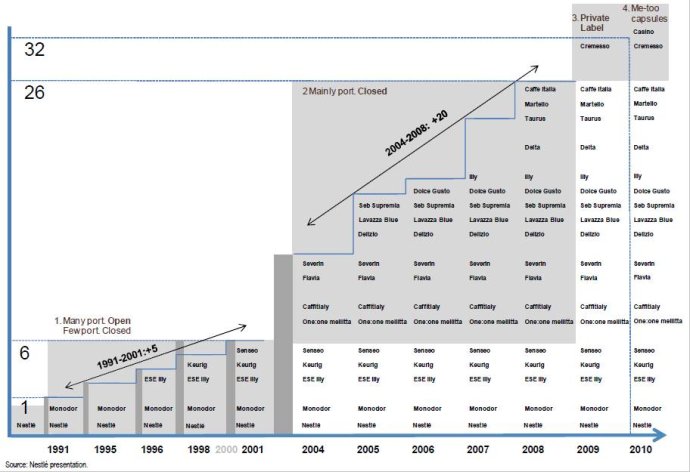
According to the map of the players in the single-cup coffee market provided by Nestlé and the latest developments in the coffee industry, there are currently more than 20 single-cup coffee systems on the market. And industry players are still experimenting with new innovations to cater to growing consumer demand for single-cup coffee, such as Starbucks 'Verismo, announced for year-end launch, KEURIG's just-launched KEURIG VUE and upcoming year-end espresso single-cup machines, Walmart's low-cost single-cup system to be launched next year, and more.
At present, single-cup coffee machines are sold on the market, most of which are closed systems, that is, only single-cup coffee bags with unique brands or authorized brands can be used. The packaging form of this single-cup coffee is capsule or cup or dish shape, and the names are also different. A few platforms are open, allowing individual manufacturers to produce coffee suitable for the single-cup coffee maker.
But closed platforms have always faced a problem with copycat single-cup coffees, i.e., single-cup coffees produced by other brands without authorization that can be used on these closed platforms. For this reason, there are constant lawsuits between major manufacturers. In Europe, Nestlé launched several infringement lawsuits against Sara Lee against Nespresso.
After the expiration of the patent for single-cup coffee packaging technology on some platforms, some participants in the coffee industry are also eager to enter a piece of the pie, such as Sara Lee in Europe has launched Italian coffee capsules that can be applied to Nespresso; In North America, Tree Food tries to launch instant coffee K-CUP without filter paper, ROGERS launches ONE-CUP instant coffee, etc.
European Single Cup Coffee Market
The Western European coffee market is a mature market, with a compound growth rate of 6.1% in sales over the past five years, mainly from the single-cup coffee market. The chart below shows that the Western European single-cup coffee market has experienced a compound growth rate of more than 20% over the past five years.
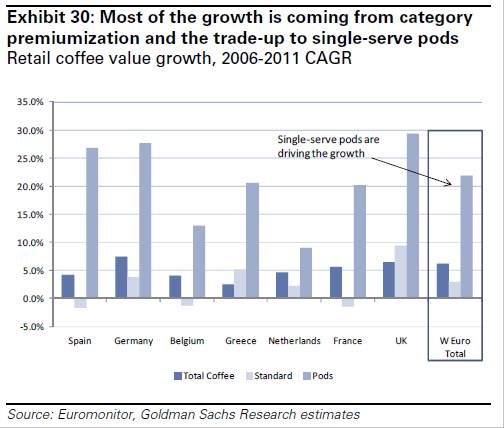
Europe, as the birthplace of single cup coffee, has achieved high permeability in Western Europe, and the penetration rate in some countries is as high as 40%. In Switzerland, single-cup coffee bags account for nearly 50 per cent of the total, compared with nearly 40 per cent in France. The main participants of European single cup coffee are Nespresso of Nestl é, Senseo of Sara Lee, Tassimo of Kraft and so on. However, the European single cup coffee market, the concentration is not high, in addition to the above four major brands, there are still many brands in the competition.
The following picture shows the market share (by sales) of European single cup coffee brands.
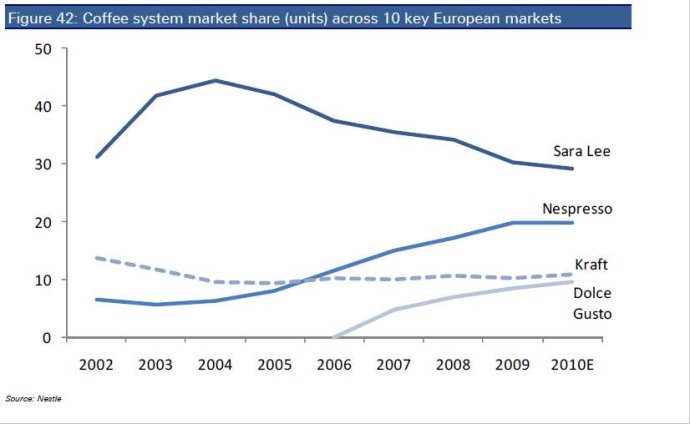
Let's first focus on Nestle's Nespresso single cup coffee system.
The following figure shows the Nespresso machine:
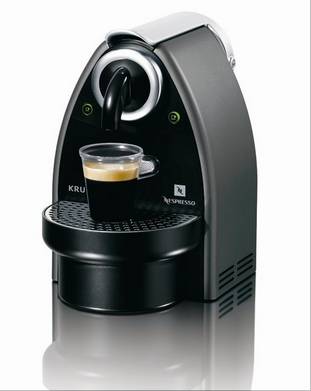
The following picture shows the Nespresso capsule.

Some people call the Nespresso system "the Louis Vuitton of the food industry". Still, after Nestl é created the Nespresso system 30 years ago, it still took nearly a decade before it broke even. Here are the main points of the brand's development trajectory:
1982: the R & D department of Nestl é put forward the concept and design of Nespresso capsule
1986: Nespresso S.A. Established, and did a sales test in the Japanese market
1989: Nespresso Club founded
1995: Nespresso breaks even
1998: launch of online service website for members
2003: the first flagship store opens in Munich, Germany
It is estimated that Nespresso achieved sales of 4 billion Swiss francs in 2011, an eightfold increase in the past eight years! (see figure below)
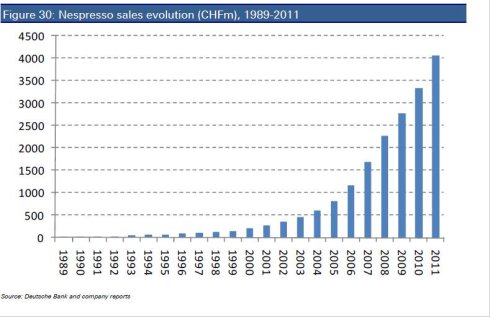
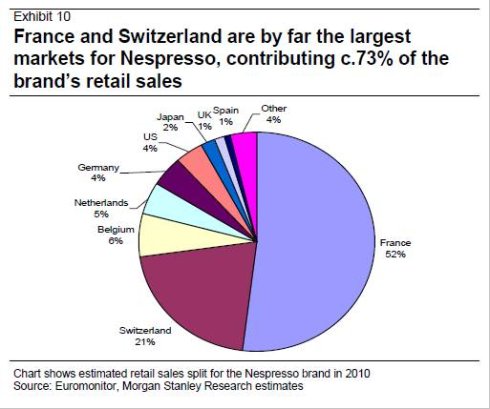
As the picture above shows, most of Nespresso's sales come from France and Switzerland in Western Europe.
Nestl é has adopted the practice of opening a direct boutique store for Nespresso, turning the product into a luxury product and completely rejecting any third-party sales channels. Attract customers through the display of boutiques, and retain customers with service and good experience. So 50% of Nespresso's sales come from online sales, more than 30% from the company's boutiques, and about 20% from the company's telemarketing. Nestl é currently operates 270 Nespresso boutiques. The following table shows the number of flagship stores in different countries.

Another feature of the Nespresso system is that Nestl é controls almost all the value chains of the system. At present, except for the Nespresso machine manufactured by a third party, all other links are controlled by the company. This helps Nespresso raise its gross margin and, more importantly, this control enables Nestl é to ensure the quality of the brand and its high-end market image. At the same time, Nestl é uses extremely high customer service to strengthen its brand image.
Take France as an example, the service level of Nespresso is as follows: (1) free delivery of more than 200 capsules; (2) pick up the goods at the boutique one hour after placing the order (from 10:00 to 7 p.m., Monday to Saturday); (3) online booking or telephone booking of capsules, which can be picked up at the nearest convenience store and notified by email or SMS when the goods arrive at that location; (4) Free participation in the storefront interaction organized by Nespresso experts 5. if there is something wrong with the machine, the company will provide door-to-door service; during the repair period, lend the customer a new machine; after the repair, send it back to the customer.
At the same time, Nestl é has set up a strong database of customers' data to study their use times, preferences and so on. Because customers have to show their Nespresso club membership card number when ordering capsules, Nestl é can provide accurate and personalized service and follow up on customer consumption changes.
At the same time, Nestl é is making innovations in machines to create a high-end brand image of Nespresso, such as launching machines designed by Porsche, sponsoring events, forming business partnerships with some airlines or high-end hotels, and inviting George Clooney to endorse Nespresso products as brand ambassadors.
Senseo single cup coffee system:
In 2001, Philips and Sara Lee jointly developed and launched the Senseo single cup coffee system, which was welcomed by consumers in the market, especially in Western Europe. In 2008, Senseo launched an updated machine that has a separate milk tank and continues to use the original coffee bag standard to make three different types of coffee with milk: cappuccino, latte macchiato and fragrant latte. The improved Senseo system does not make a real espresso, it is still American coffee (regular coffee), just with milk bubbles. Due to the cheaper price of the machine, according to Sara Lee's promotional materials, Senseo has sold a total of 23 million units worldwide. However, due to poor sales in North America, Senseo has announced that it will withdraw from the North American market at the end of March 2012. Meanwhile, on January 26, 2012, Sara Lee bought Philips's interest in Senseo from Philips for $220 million and partnered with Philips to develop a new Senseo single-cup coffee machine.
Although Senseo was the first participant in the single-cup coffee market, the progress of Senseo has been slow in recent years, especially in the United States. In this regard, Sara Lee chairman Bennink and Reuters said in an interview: "our Senseo machine is not a sexy machine, if I ask my daughter if she needs a Senseo machine, she will answer: no, thank you." This is the most direct answer you can get from young people who hate to have anything to do with Senseo. "
The following picture shows the Senseo machine and the matching coffee bag.
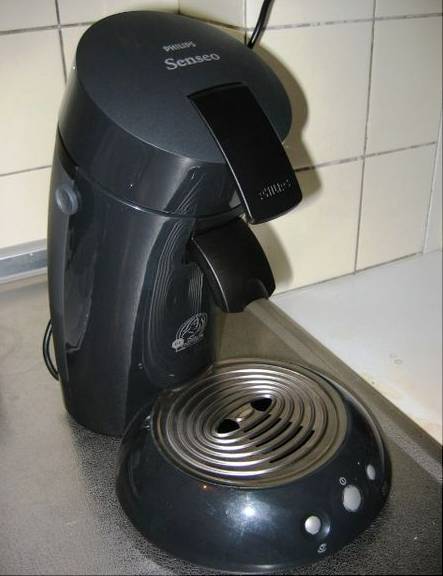
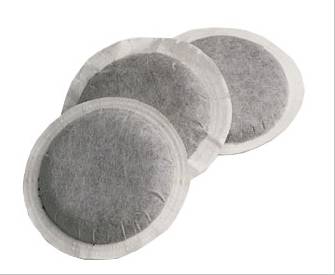
With regard to the patent protection of pods, a coffee bag matched with Senseo, the European Patent Office granted Senseo the patent in July 2001. However, in February 2004, when a Belgian court accepted an infringement lawsuit between a Belgian coffee company and Senseo, it was found that other families could generate and sell pods for Senseo, thus breaking the monopoly of Senseo pods, so that all coffee merchants in the Benelux economic union could produce the pods. On August 30th, driven by strong opposition from other large companies, the European Patent Office ruled to abolish the patent of Senseo system for its pods. Since then, Senseo has become a fully open single-cup coffee system, and any manufacturer can produce a coffee bag pods suitable for the coffee machine.
Tassimo single cup coffee system:
In 2004, Kraft Foods launched the Tassimo single cup coffee machine system in the French market, followed by Western European and North American countries. The system can make single cup espresso, American coffee, tea, hot cocoa and single cup drinks such as latte and cappuccino with milk. The Tassimo machine, made by Bosch in Germany in 2008, comes with a coffee bag: t-disc (T-DISC). See the following figure:
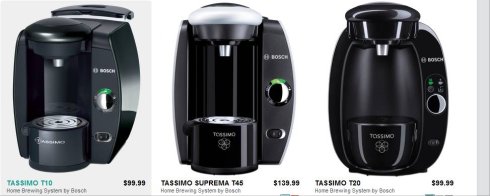


At present, the brands of T-disc are: Gevalia, Maxwell, Jacobs, Carte Noir, Twinings, Suchard and so on. At the end of 2007, Starbucks joined the North American T-disc, but at the end of 2010, Starbucks withdrew from it.
The T-disc is printed with a QR code. When the T-disc is put into the Tassimo machine, the machine begins to read the information on the QR code and calculate the appropriate amount of water, cooking time, water temperature, etc., the whole cooking process takes 30-60 seconds, and the milk used in the T-disc is UHT milk.
Due to several injuries, Tassimo and T-discs were forcibly recalled in North America on February 9, 2012, involving 835000 machines in the United States, 900000 machines in Canada and 4 million T-discs. This is also one of the landmarks of Tassimo's development in North America in recent years.
LAVAZZA Blue single cup coffee system
Lavazza is an Italian company that launched the Lavazza Blue espresso single cup machine in 2005. The following picture shows the machine and its espresso capsule. The Blue system is also a closed system, which can only use its matching capsules to make espresso and American coffee as well as tea drinks, but there are very few options.

In addition to the BLUE platform, Lavazza also launched the A Mode Mio espresso single cup machine system.
Dolce Gusto system:
In 2006, Nestl é launched the Dolce Gusto single cup coffee system, which can make cappuccino, latte macchiato, espresso, Lungo and other drinks, as well as hot cocoa and cold drinks. The system is also a closed single-cup system that can only use patented coffee bags. There are many models of Dolce Gusto, and the figure below is one of them:
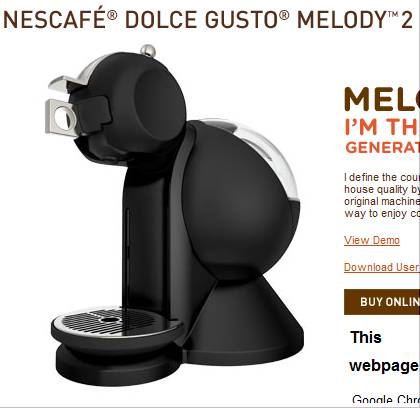
Single Cup Coffee Market in North America
There are many players in the North American single-cup coffee market, including Nespress and Dolce Gusto from Nestle, Tassimo from Kraft, Senseo from Sara Lee, Flavia from Mars, and most importantly Keurig.
The chart below shows morgan stanley's 2010 u.s. market share for single-cup coffee makers.

The above picture basically summarizes the participants of single-cup coffee machines in North America (mainly in the United States), but the statistics of market share are not accurate. According to green mountain coffee's sales revenue of $2.2 billion (KEURIG+K-CUP) in 2010, Nespresso's u.s. sales accounted for only 4% of its revenue in the same period, or $120 million. At the same time, in the recent recall of Tassimo in the United States, the United States recalled less than 900000 machines, while Senseo announced that it would withdraw from the North American market at the end of March 2012.
This evidence suggests that at the end of 2011, the single-cup coffee maker in North America was completely dominated by the KEURIG platform, accounting for more than 85% or even 90% of the single-cup coffee maker.
North American single cup coffee machine is dominated by American coffee machine KEURIG, there may be the following main reasons: 1, North American coffee consumption is mainly American coffee, the proportion of espresso consumption is very low; 2, KEURIG K-CUP brands, a full range of brands, has been basically equivalent to an open platform; 3, the design and performance of KEURIG machine.
KEURIG single cup coffee system:
KEURIG began promoting its single-cup coffee system to the North American office coffee market in 1998 and began experimenting with its single-cup coffee maker for families in 2005. Since KEURIG does not belong to a large coffee brand, at the beginning of its launch, several small coffee brands joined in, and KEURIG collected royalties. The main brands were Green Mountain Coffee, Tully "s, Coffee People, Diedrich, Gloria Jean" s, Canadian brand Van Houtte and so on. In 2006, KEURIG was acquired by GMCR and became a wholly owned subsidiary of GMCR. KEURIG is a closed single-cup coffee system, and its coffee bag is K-cup (K-CUP).
The biggest feature of K-CUP, which is different from other single-cup coffee machine coffee bags, is that in the package, there is a paper filter on which the coffee is placed and then completely sealed in a small cup-shaped package. This is tantamount to copying the working principle of the filter coffee machine.
The following picture shows the KEURIG machine and K-CUP.
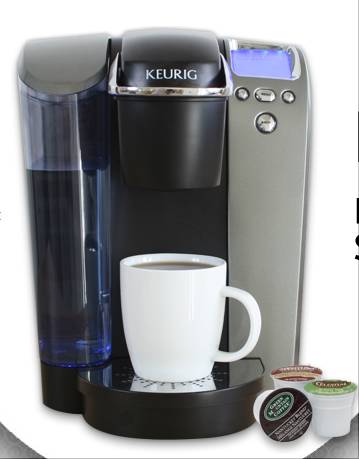
The most important feature of the KEURIG platform is that there are many coffee brands, with dozens of K-CUP types from the very beginning, and then with the continuous increase of coffee types, some tea brands such as Biglow have joined, rapidly more than 100 kinds. At the same time, KEURIG machines far outperform their competitors in terms of design sense and convenience. These factors quickly made KEURIG the most popular coffee machine in North America (not just a single cup coffee maker), and KEURIG, along with many of Apple's IPAD, IPOD and IPHONE products, became the most popular gift choice during the Christmas shopping season. In the recent Christmas shopping season, KEURIG coffee machines accounted for more than 35% of coffee machine sales and more than 50% of sales!
In 2010, Green Mountain Coffee reached an agreement with Folgers, the largest coffee brand in North America, and Folgers brands entered into K-CUP; subsequently, Dunkin "Donuts (stock symbol DNKN) reached an agreement with Green Mountain Coffee to enter Kmae Cup; Starbucks lifted all retail consignment agreements at Kraft at the end of 2010, and the Starbucks brand entered Kraft in March 2011. At this point, the major North American coffee brands, in addition to Kraft's Maxwell in their own Tassimo platform, have entered the KEURIG platform. KEURIG has become an almost completely open single-cup coffee machine platform system. At present, there are 249 types of K-CUP, including coffee, tea, hot cocoa, iced tea, apple juice and so on. In the latest quarter, non-coffee K-CUP accounted for more than 14%.
Figure: annual sales of KEURIG machines; annual sales of K-CUP.
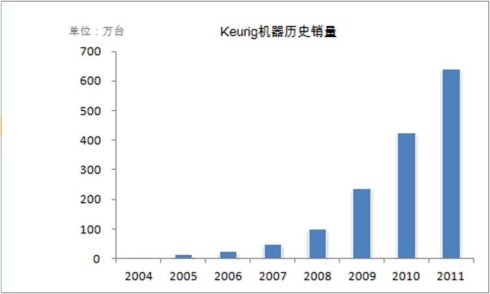
The above sales figures are fisical year, and for 2011 calendar year, the number of KEURIG sales is 8.13 million! We have counted the cumulative sales of KEURIG in its history, which has exceeded 19 million, but according to the company's management communication before Christmas, which revealed that the number of KEURIG machines is between 800 and 9 million, plus the sales of 4.2 million during the Christmas shopping season, we think the current number of KEURIG machines is about 1200 to 13 million. The above holdings take into account the impact of the proportion of KEURIG mini and the problem of machine waste, because the mini model does not have a water storage tank and is small, and many consumers buy mini mainly because they use it when they go on vacation or occasionally as a supplement to a home coffee maker.
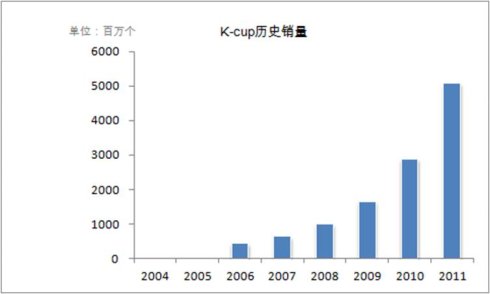
In fiscal year 2011, K-CUP sold 5 billion cups; it is expected to exceed 8.6 billion cups in fiscal year 2012.
Tassimo system:
Sales of the system in North America are failing. Due to poor sales, Starbucks withdrew its Tassimo at the end of 2010; Tassimo was removed from many sales channels; and Tassimo machines and T-DISC were recalled in North America in February 2012 due to frequent security incidents.
Senseo system:
Sara Lee announced that by the end of March 2012, Senseo will withdraw from the North American market and retain only online sales.
CBTL system:
CBTL single cup coffee machine system is an Italian coffee single cup machine system developed by The Coffee Bean & Tea Leaf, which can produce more than ten kinds of beverages, including espresso, American coffee, tea and so on. The design and structure of its coffee bag is similar to K-CUP. At present, CBTL is trying to sell in some stores in North America, such as BBBY and TARGET. There are three CBTL machines to choose from: $139.95, $149.99 and $179.95; coffee bags sell for $7 per 10.
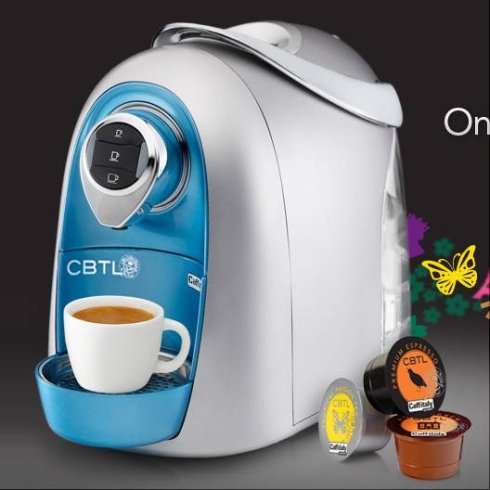
KEURIG
Second generation machine: VUE system
This is Green Mountain Coffee's new single-cup coffee system announced in February 2012, continuing the excellence of the first generation of machines, but at the same time the new VUE-PACK improves the shortcomings of the first generation K-CUP too weak, and adds new options for lattes and cappuccinos with milk. The system will go on sale next quarter on BBBY, company websites, etc.
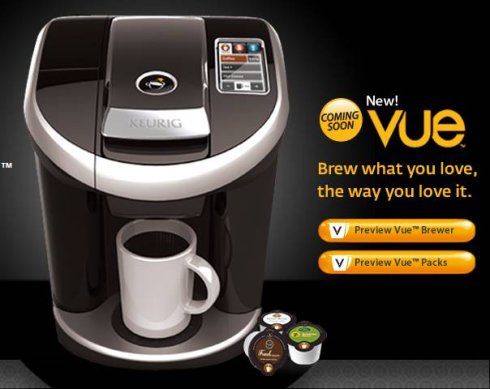
Verismo of Starbucks
Italian coffee machine system:
Starbucks announced in March 2012 that it would launch its own single espresso machine, Verismo, by the end of the year.
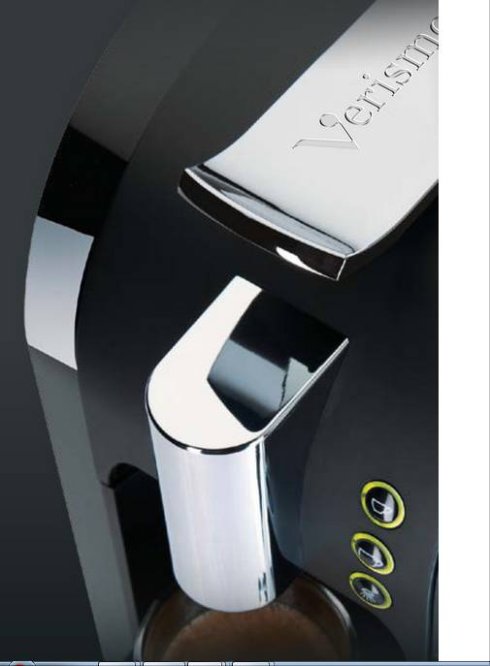
4. Comparative analysis of several main platforms:
The following table lists the machine prices of the main single-cup coffee machines, which are higher than traditional coffee machines.
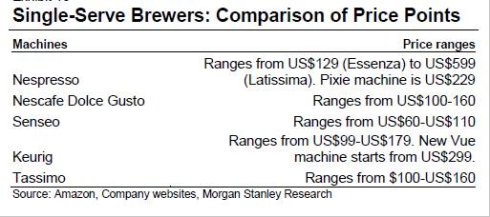
The advantages of KEURIG are shown in the figure below. Taken together, consumers' evaluation of the KEURIG coffee maker is the highest in a number of projects, far exceeding its competitors, which is the main reason for its popularity.
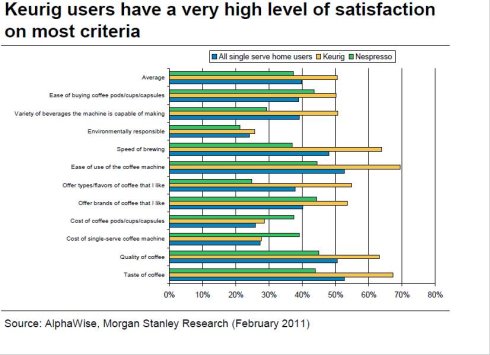
The following is a simple comparison of several single-cup espresso machines:
As far as the price of coffee bags is concerned, there is also a big difference. The situation in Western Europe and North America is completely different. The price of a single cup coffee bag in Western Europe is significantly lower than that in North America, even if it is the same brand of coffee bag, such as nespresso capsule.

The figure below shows that nespresso's pricing in Western Europe and North America is compared with that of its competitors, and it can be seen that nespresso has taken a completely different position in North America. But even so, nespresso has been slow to roll out in North America, with revenue from North America contributing only 4 per cent.
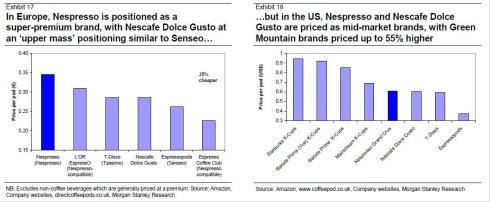
V. Market capacity of single cup coffee and its future development
Since Nestl é launched the Nespresso single cup coffee system in 1986, the single cup coffee market has developed rapidly. Monodor entered the market in 1991, Illy entered in 1996, Keurig entered in 1998, Sara Lee's Senseo entered the market in 2001, and then Mars's Flavia, Kraft's Tassimo and Nestl é's Dolce Gusto were introduced to the market from 2004 to 2008.
Nestl é estimates that global sales of single cups of coffee currently account for 8% of all coffee sales and 20% of sales. Starbucks recently estimated that the global single cup coffee market capacity has reached 8 billion US dollars, of which half is Italian coffee single cup, half is American coffee single cup. The figure below shows the penetration levels by volume and amount in the top 10 countries with the highest penetration rates for a single cup of coffee.
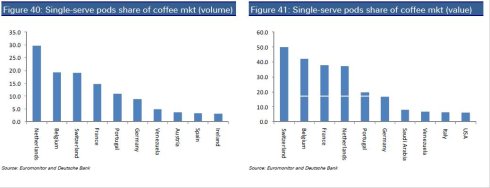
The chart below shows the share of single-cup coffee sales in major countries worldwide in 2010, with several countries in Europe accounting for more than or close to 50%.
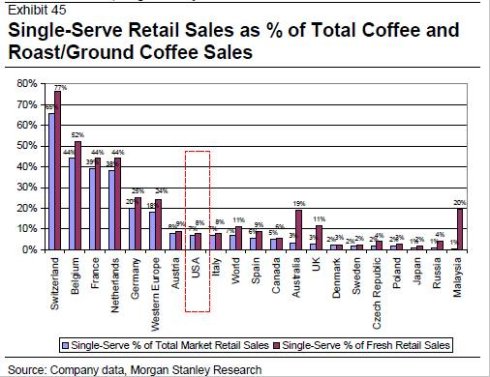
According to a 2011 Morgan Stanley survey of more than 1500 consumers in North America, the U. S. single-cup coffee market may be undergoing an accelerated penetration phase. This is exactly in line with the recent sales of 4.2 million KEURIG machines during the recent Christmas shopping season.
The price of a single cup of coffee is debated: is the cost too high?
Some researchers have pointed out that compared with regular coffee, the price of a single cup of coffee is too high, and some even claim that the price of a single cup of coffee is more than five times that of regular coffee.
There may be a big fallacy on the basis of this comparison. Some comparative details can not be ignored, such as the quality of coffee consumed, preparation time of traditional coffee consumption, cleaning and waste in the process, and so on.
The competitive situation in the single-cup coffee market: the problem of imitating coffee bags
Since most single-cup coffee machine platforms are closed, some leaders with large holdings are bound to face the competitive problem of copying coffee bags, such as nespresso and keurig. However, due to the multiple patent protection of these platforms, some legal disputes arise.
In North America, imitations of K-CUP have been emerging in the past two years. The repeatedly used RE-USE K-CUP has always been a standard accessory for KEURIG machines, allowing consumers to pour their own coffee into it and use it in KEURIG machines. At the same time, many companies have introduced accessories that can be reused on KEURIG machines and disposable imitation K-CUP. At the end of 2010, TREE FOOD launched an imitation of built-in instant coffee without a filter, and in 2011, ONE-CUP, which also does not include a filter and has built-in instant coffee. But these imitations all have a common problem, which is of poor quality.
In Western Europe, imitations of nespresso capsules have emerged one after another.
In April 2010, Sara Lee launched L "OR Espresso capsules for nespress machines in France and sold them in Carrefour; in May, ECC, a company founded by Nespresso's former CEO, launched similar capsules in France; in June 2010, Nestle sued Sara Lee and ECC in France for patent infringement; and in June 2011, Sara Lee launched L" a Rome Espresso capsules for nespresso in Spain and Belgium. In October, ECC launched similar capsules in Germany, Austria and Switzerland.
With regard to the problem of imitation, the strategies adopted by the companies are not exactly the same. Upgrading is a common practice, with nespresso introducing the Dolce Gusto machine and Green Mountain Coffee introducing the KEURIG upgraded version of VUE, which extends the patent. At the same time, Green Mountain Coffee is also committed to the establishment of the enterprise ecosystem, basically building KEURIG into an open platform.
(if you reprint this article, please indicate the source!)
Author: Haijin Source blog)
Important Notice :
前街咖啡 FrontStreet Coffee has moved to new addredd:
FrontStreet Coffee Address: 315,Donghua East Road,GuangZhou
Tel:020 38364473
- Prev
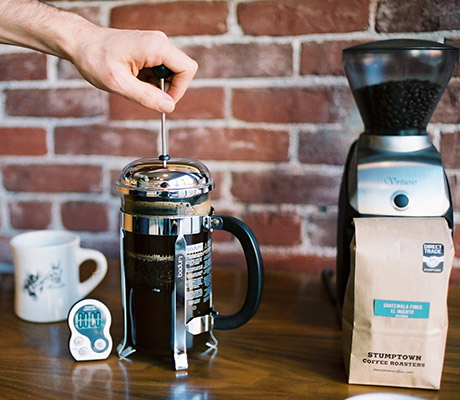
Coffee brewing method: how to use the mocha pot correctly? What are the main points to pay attention to when using a mocha pot
How to use the mocha pot correctly if it is the first time to use the mocha pot, unscrew the top spout, remove the coffee filter, and check whether the filter and rubber band under the upper pot have been installed. Soak the mocha pot in hot water and wash it. Then dry it and pack it as it is. Then we can start making delicious coffee. 1. First pour warm water into the pot, pay special attention to it
- Next
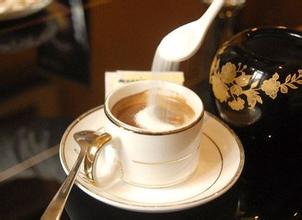
What is the coffee partner added to coffee? Can you replace it with milk and sugar?
Yes. The main ingredient of coffee mate (commonly known as creamer) is plant fat powder. Vegetable fat powder is a general term for vegetable fat powder. Vegetable fat powder has a wide variety of functions and applications. Its production history can be traced back to the 1950s. It has been widely used in baked food ingredients, cold food ingredients, confectionery ingredients and solid beverage ingredients. Use creamer (milk) in coffee
Related
- What is the meaning of lactic acid fermentation with coffee bean treatment?
- How to judge the state of foam by sound?
- How does the latte pull out the unicorn pattern? Come to get for a little trick to improve the flower pull!
- Will flower pulling affect the taste of the latte?
- Do you know the history of coffee?
- The difference between honey treatment and sun washing what is raisin honey treatment?
- What kind of milk can a novice use to make coffee foam to keep the foam longer? The correct method and skills of milking tutorial sharing
- Why do washed coffee beans taste sour? Flavor characteristics of washed Coffee
- Introduction to the skill of how to practice the size and height of water injection around the circle of hand-brewed coffee
- How do beginners practice coffee flower drawing from scratch?

